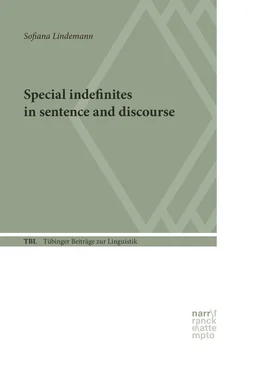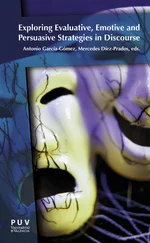Research in the field (MacWhinney 1977, Gernsbacher and Shroyer 1989, Gordon et al. 1993, McDonald and MacWhinney 1995) has argued that it is not only the (parallel) subject position, which influences the accessibility of referents in terms of likelihood of subsequent mention, but that the linear order of mention matters as well. According to this view, the first mentioned referent in a sentence occupies a privileged slot within the sentence, independently of its grammatical function. In many languages, among others in English, German and Romanian, the first-mentioned referent is most often realized in grammatical subject position. Despite this correlation, research has shown that in cases in which these two positions can be kept apart, both factors influence reference resolution (Kaiser and Trueswell 2008). Consequently, first mentioned referents tend to be picked up by less explicit types of referring expressions compared to other referents.
2.3.3.4 Semantic prominence bias
The semantic or thematic role bias has often been linked to the accessibility of a referent (Stevenson, Crawley and Kleinman 1994, McDonald and MacWhinney 1995, Arnold 1998, 2001, Kehler 2002, Kehler et al. 2008). Stevenson et al. (1994) ran several written story completion studies and showed that referents bearing certain thematic roles are more likely to be mentioned in the subsequent discourse and to show higher rates of pronominalization than referents realized in other semantic roles. For example, in a sentence describing a transitive event, in which the thematic roles Source and Goal are realized, discourse participants often chose pronouns to pick up the Goal referent (given syntactically controlled constructions). In Stevenson et al.’s study (1994), participants were given story fragment passages like in (15a) and (15b) and were asked to add a continuation sentence to the initial story. Note that the second sentence of each test item ended in an ambiguous pronoun prompt, which could refer back to both female referents introduced in the first sentence.
| (15) |
(a) |
Sarah GOALtook the cat from Rebecca SOURCE. She_______ |
|
(b) |
Sarah SOURCEpassed the salt to Rebecca GOAL. She_______ |
The experimental findings reported in Stevenson et al.s’ study showed that the stories were continued with the pronoun she referring to Sarah rather than to Rebecca in (15a), as Sarah was not only the subject referent, but was also realized as the Goal referent. In a sentence describing a transitive event in which the semantic roles are reversed, such that the Source corresponds to the subject position and the Goal to the object position, as illustrated in (15b), the participants in Stevenson et al.’s (1994) experiment did not show a pronoun assignment preference towards one of the two referents. In other words, half of the participants resolved the pronoun in the second sentence to the Source=subject referent and the other half of the participants resolved it to the Goal=object referent. Stevenson et al. interpreted these results by assuming the existence of two preferences or biases being at work in contexts like in (15), namely a subject bias and a semantic or thematic role bias. While the two preferences overlap in the Goal=subject condition in (15a), resulting in more pronoun interpretations towards the referent realized in this way, the two preferences compete in the Goal=object condition in (15b). As a result, an otherwise low in prominence object referent becomes more prone to be subsequently pronominalized. An important observation pertains to the fact that two preferences compete in determining the likelihood of subsequent pronominalization.
2.3.3.5 Implicit causality
Implicit causality has been shown to impact the likelihood of pronominalization of particular referents as well. Previous investigations have noted that besides their actual meaning, certain verbs encode additional aspects about the events they describe (Chafe 1972). These additional aspects include objects, causes and consequences that are typically associated with the event evoked by the verb. For example, when talking about a stealing event, people activate different roles that are typically linked to this event, as “the burglar”, “the loss”, “the insurance” and so forth. Such associations licence the use of the definite article for typical objects, even though they do not refer back to an explicitly introduced antecedent. Not only typical objects are being activated by verb meanings, but also different other events that represent natural continuations of the initial event. In the given example, the cause or the consequence is activated by the verbal meaning as well. This observation was taken as an argument that the verb to steal has an inherent feature of causation. Garvey and Caramazza (1974) argue that implicit causality is one of possibly many aspects of “world knowledge” that speakers and hearers use in communication. Implicit causality enables hearers to correctly assign an ambiguous pronoun towards the object referent in (16a) and towards the subject referent in (16b).
| (16) |
(a) |
Jane 1hit Mary 2because she 2had stolen a tennis racket. |
|
(b) |
Jane 1angered Mary 2because she 1had stolen a tennis racket. Caramazza et al. (1977) |
To identify the biases in pronoun assignment, hearers have to correctly compute the causality relations between two events. For example, in (16a) they have to understand that the event described in the first sentence is a reaction towards what Mary did, and in (16b), hearers have to understand that Mary is angered, because Jane stole a tennis racket. Garvey and Caramazza (1974) divided verbs into three classes depending on the direction of pronoun resolution, i.e. whether a pronoun refers back to the first noun phrase of the preceding clause (NP1-bias), whether it refers to the second noun phrase (NP2-bias), or whether it is neutral towards the preceding noun phrases (neutral). Typical English verbs that are biased to the first noun phrase in the preceding context are anger , frighten , delight ; verbs that are biased to the second referent are hit, scold, admire ; and verbs that are neutral with respect to a particular referent are see, babysit, notice .
Moreover, Au (1986) showed that the way in which the first sentence is continued has an impact upon the referent that will be subsequently mentioned. For example, a full stop after the first sentence and the omission of the subordinating conjunction because has the effect of neutralising or even reversing a particular bias to a noun phrase, as illustrated in (17a). On the contrary, participants who were asked to continue a sentence like the one in example (17b) showed a systematic preference to pick up the first referent (she=Paula) in the subsequent discourse, and the pronoun in the second conjunct was resolved to this subject referent.
| (17) |
(a) |
Paula infuriated Mary. Paula/ Mary _____________. |
|
(b) |
Paula infuriated Mary because she PAULA_________. |
Stevenson et al. (1994) accounted for these observations by arguing that subordinating conjunctions like because have a direct impact on the accessibility of referents, making these more susceptible for pronominalization. In sum, implicit causality was shown to be an important factor in pronoun resolution, which is generally resolved at clause boundaries (Koornneef and van Berkum 2006).
2.3.3.6 Intersentential coherence relations
More recent approaches to anaphora resolution emphasize the crucial role played by intersentential semantic coherence relations in correct pronoun assignment. Following the work of Hobbs (1979), Kehler (2002), Rohde (2008), Kehler et al. (2008), Kaiser (2010) argued that coherence relations, which hold between two adjacent clauses, can be of various types, as for example causal relations (e.g. as a result ), temporal relations (e.g. next ), to name just a few. Moreover, discourse participants are said to build forward-looking expectations about the ensuing discourse based on the coherence relations they assume to hold between sentences. To illustrate how the coherence relations contribute to pronoun interpretation, consider examples (18a) and (18b), adapted from Kehler et al. (2008).
Читать дальше












